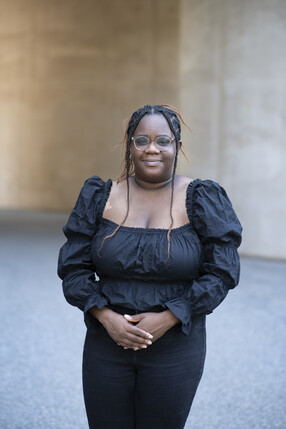School of Life
Looking to biology for models of more efficient—and sustainable—inorganic chemistry

Lisa Awaitey is not a morning person. She was even less of one when she was in high school growing up in Scotch Plains, New Jersey. But she—and the sleep-deprived mother who drove her to school—somehow made it to class every morning at 630 a.m. The reason? Ms. Hofer.
“We were coming up on the AP chemistry exam and my teacher Ms. Hofer had us all at school early so that we could prepare,” Awaitey remembers. “She taught us about equilibrium and acids and bases. She would come up with these ridiculous rhymes and slogans to help us remember important terms and concepts. I still use them today when I teach undergraduates. She made chemistry so much fun. When I took her class, I realized that there could be a career path for me in the field.”
The daughter of Ghanaian immigrants, Awaitey has followed the path that her high school teacher helped her forge all the way to Harvard’s Graduate School of Arts and Sciences (GSAS). Here, as a PhD student in chemistry and chemical biology, she learns from a different tutor—nature —as she studies biological processes to build synthetic models that mimic them. It’s work that could inspire solutions to one of humanity’s biggest challenges: climate change.
Mimicking Nature

Awaitey studies inorganic chemistry—a field focused on compounds that do not contain carbon. In the lab of Erving Professor of Chemistry Theodore (Ted) Betley, the PhD student is part of a team working to develop synthetic compounds that mimic the enzymes found in nature—specifically nitrogenases.
Nitrogenases occur as cyanobacteria, organisms that live in the water and are capable of photosynthesis. In nature, these enzymes catalyze a chemical reaction that enables nitrogen to transform into ammonia at an ambient temperature. The industrial production of ammonia, on the other hand, takes enormous amounts of energy, heat, and pressure that leave a large carbon footprint. Because the chemical is vital to agriculture—about 80 percent of all ammonia produced is used in fertilizer—finding a way to make it that's similar to the efficiency of nature would be a boon, particularly in efforts to address climate change.
The challenge is that many different types of nitrogenases exist, and scientists have had difficulty isolating the catalyst that transforms nitrogen into ammonia. To study the biological reaction more closely, researchers need a synthetic model. “The importance of having a model is that it would give us a vehicle to probe electronically, to probe structurally, and to probe with small molecules to see how biology causes these transformations,” Awaitey says.
Awaitey’s contribution to the model has to do with metal hydrides—materials that consist of metals such as iron bonded to hydrogen. “For nitrogenase to spur the reaction to ammonia, a metal hydride must be formed,” she says. “The same thing applies to the industrial process. That means that there’s something special about metal hydrides in the transformation from nitrogen to ammonia. I want to know what that is.”
The importance of having a model [of the transformation of nitrogen into ammonia] is that it would give us a vehicle to probe electronically, to probe structurally, and to probe with small molecules to see how biology causes these transformations.
The Betley Lab’s work goes beyond a more sustainable way to produce ammonia. Awaitey points out that nitrogen molecules are held together by a very strong bond. If scientists understand how to break those bonds, they can use that knowledge to alter the molecular structure of substances in ways that could have a dramatic impact on climate change.
“Take methane,” Awaitey says. “It’s one of the most damaging greenhouse gases. But what if we could take it out of the atmosphere and transform it into methanol, a useful and renewable liquid fuel? It could have a real impact on atmospheric warming.”
Betley, Awaitey’s advisor, says that her research plays an important role in the effort to build new models that will enable scientists to understand enzymes—and the reactions they catalyze.
“In biology, the reactive species that are critical to function are often too fleeting to be observed, let alone studied in any detail,” he says. “Lisa's work focuses on making reactive analogs that can be studied so we can probe how all the moving parts function together. Her work on cluster hydrides will enable us to understand their properties and reactivity. By detailing their properties, we can infer how biology might function and guide our understanding of how to better make synthetic catalysts.”
More People Like Me
Faculty and colleagues like Betley—along with the community Awaitey's found at Harvard—have enabled her not only to work with brilliant people at facilities that are among the best in higher education but also to thrive as a student of color. It’s a situation she doesn’t take for granted, given some of her past experiences.
“When I was an undergraduate at Cornell,” she says, “the courses were challenging academically and also because there weren’t a lot of people in my classes who looked like me or came from a similar background. Fortunately, my research advisor was committed to helping underrepresented minorities in science. He taught me a lot of chemistry and also that, with the right support and encouragement, there could be more people like me in the field.”
Happily, Awaitey’s research advisor wasn’t the only person she encountered at Cornell who was supportive of students with different backgrounds and perspectives. Even so, she says that she sometimes also encountered subtle microaggressions. In a class on thermodynamics, for instance, she derived her own equation to solve a problem. She even validated her approach with the teaching staff before an upcoming exam. After the test, however, things seemed to change.
“The professor didn’t believe that I derived the equation myself,” she says. “He gave me a blank piece of paper and asked me to do it again. So, I did, and he said it was fine. But it was such a strange experience. I felt like he doubted that I could do the work.”
Awaitey chose GSAS for her PhD program because she knew that the confidence she had in her own potential would be reflected—and amplified—by an advisor like Betley and by a school that was committed to diversity and inclusion.
“Ted is incredibly supportive of my research and my career,” she says. “My undergraduate advisor at Cornell had actually taught him when Ted was an undergraduate, so he recommended that we connect. Along with my advising relationship, the programs and people of the GSAS Office of Diversity and Minority Affairs have allowed me to meet people trying to achieve the same things academically that I am and to build a community that enables me to thrive.”
While Awaitey’s mother drove her to Ms. Hover’s classes all those years ago, her father was just as supportive of her desire to be a scientist. Sadly, he passed away in January 2021. Even as she mourns him, Awaitey says that she will always remember how proud her father was when she was admitted to GSAS and how he encouraged her to enroll.
[My father] reminded me that I was good enough, smart enough, and capable of being a student at Harvard. Unfortunately, he won't be here physically to see me graduate, but I always promised him I would put a 'Dr.' in front of our last name.
“When I was unsure or anxious, he was always there to calm me down,” she says. “He reminded me that I was good enough, smart enough, and capable of being a student at Harvard. Unfortunately, he won't be here physically to see me graduate, but I always promised him I would put a ‘Dr.’ in front of our last name.”
As she gets closer and closer to fulfilling the vow she made to her father, Awaitey is excited about the prospects for her research and the impact it can have. There’s still much to be discovered, but nature, like Ms. Hofer, is a great teacher.
“Since biology can do these transformations so efficiently,” she says, “we can learn from that and build platforms to do the reactions in larger settings and in a way that is less resource-intensive. We’re a long way from that end goal, but that’s what we’re aiming for.”
Photo by Tony Rinaldo; Banner Illustration courtesy of Shutterstock
Get the Latest Updates
Join Our Newsletter
Subscribe to Colloquy Podcast
Simplecast





